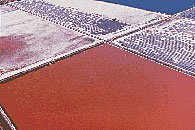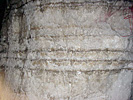 |
 |
Estuarine Science

Salinity
Does table salt come from the ocean?
When seawater is separated from the ocean (in a lagoon, pond, or in a jar) and the water evaporates, salts will form and settle to the bottom. The first salt will form (precipitate) after about 75% of the water has evaporated. This first salt is calcite or calcium carbonate (CaCO3). As evaporation continues, gypsum (CaSO4 · 2H2O) is the next salt to form. This continues until about 90% of the water is evaporated. At this point, sodium chloride (NaCl) will form and will continue to form until 96-97% of the water has evaporated. There are still elements dissolved in the water and they will form more salts if all the water is evaporated. Sodium chloride makes up most of the salts that are formed.
 | Four ponds on San Francisco Bay used for commercial salt production. Three of the ponds have been drained and the salt is being harvested in the top pond. The bottom pond has not been drained and is red because of the red algae that grow in the high salinity. By permission from Cargill Salt Company, copyright Cargill Salt Company at http://www.cargillsalt.com/sfbay/index.html
(Click for larger image) |
This process is used to make table salt in places like San Francisco Bay in California. Ancient cultures, such as the Maya, also used this process to make salt. Salt is formed naturally in the same way. Salt deposited in ancient bays and ponds all over the world is mined for salt.
In the year 2000, there was 210,000 metric tons of salt produced worldwide. About 25% of the salt produced comes from evaporating seawater. The rest comes from old deposits. The United States consumed 53,300 metric tons of salt in 2000. Only 3% of that salt was for food. The biggest use of salt in the United States is for chemical processing (45 percent) and road de-icing (31 percent).
(From: U.S. Geological Survey, Mineral Commodity Summaries, January 2001)
Return to "What is Salinity?"
 (Image credits are listed in Image Index)
(Image credits are listed in Image Index)
|
 |



